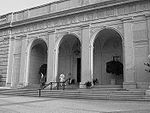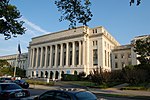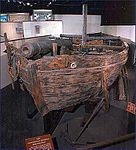Smithsonian station

Smithsonian is a side platformed Washington Metro station at the National Mall in Washington, D.C., United States. The station was opened on July 1, 1977, and is operated by the Washington Metropolitan Area Transit Authority (WMATA). It is a stop on the Blue, Orange and Silver Lines. The station's south entrance is at the southwest corner of Independence Avenue and 12th Street, Southwest, the street elevator is at the northwest corner of the same intersection, and the north entrance is on the south side of the Mall near Jefferson Drive, Southwest. The station is named for its proximity to the Smithsonian Institution's museums and is close to the Washington Monument, the Tidal Basin and other tourist attractions on and near the National Mall. The station is also near several federal office buildings, including those of the Department of Agriculture and the Department of Energy.
Excerpt from the Wikipedia article Smithsonian station (License: CC BY-SA 3.0, Authors, Images).Smithsonian station
Jefferson Drive Southwest, Washington
Geographical coordinates (GPS) Address Nearby Places Show on map
Geographical coordinates (GPS)
| Latitude | Longitude |
|---|---|
| N 38.889083333333 ° | E -77.028388888889 ° |
Address
National Park Service Information
Jefferson Drive Southwest
20560 Washington
District of Columbia, United States
Open on Google Maps










